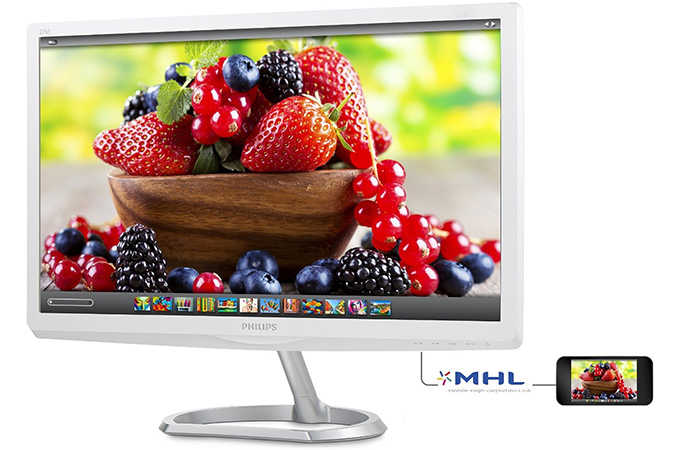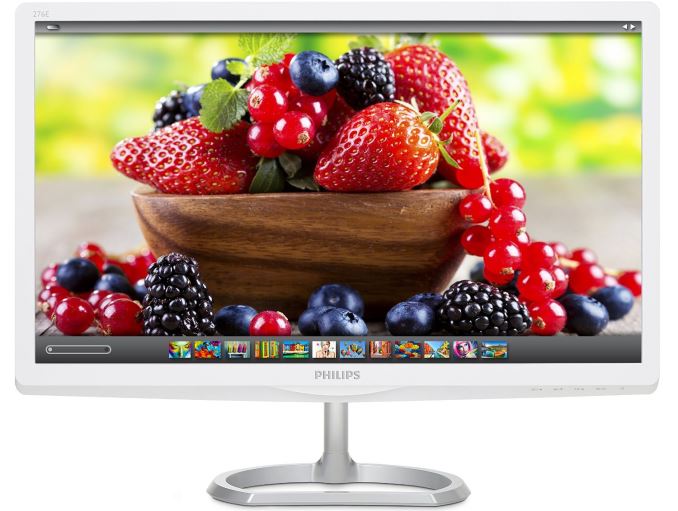Philips Begins Shipments of LCD Monitors with Quantum Dot Technology
by Anton Shilov on March 18, 2016 5:00 PM EST
TPV Technology, the company that produces monitors under Philips brand, has started to sell displays with QD Vision’s Color IQ quantum dot technology. What makes this notable is that QD Vision's technology is one such method being developed to significantly and inexpensively increase color gamut that displays can produce. The new 27” monitor can cover 99% of Adobe RGB color space, and is launcing at just $299.
The quality of LCD monitors as well as their ability to accurately display colors depends on multiple factors, including the quality of their panels as well as backlighting. While there are panels which can cover very wide color gamuts, since typical LED backlights usually do not produce whites with a broad underlying color spectrum, color accuracy of actual mainstream monitors gets limited. Several companies, including 3M and QD Vision, propose to apply special quantum dot filters on the backlights to make them as “white” (and therefore as broad) as possible.
QD Vision’s Color IQ quantum dot technology is based on cadmium selenide semiconductor nanocrystals, which can very precisely control spectral output of LED backlighting, essentially allowing light to be shifted to other wavelengths in a controlled manner. The quantum dots can be made to emit at any wavelength beyond the source wavelength with very high efficiency and narrow spectral distribution, which helps to make backlighting cleaner and thus enhance color gamut of displays. Applying quantum dot filters in any form is a relatively cost efficient task because it is basically a process step in assembly of an LCD module. However, those filters have to survive temperatures produced by LEDs, which is why they are not applied everywhere.
The Philips 276E6ADSS monitor is based on a 27" IPS-ADS panel with 1920×1080 resolution, 178°/178° horizontal/vertical viewing angles, 1000:1 contrast ratio (20M:1 dynamic contrast ratio), 300 cd/m2 brightness, 5 ms gray-to-gray response time and 60 Hz refresh rate. The display features a D-Sub, a DVI and an HDMI with MHL connectors along with audio in and out. Thanks to quantum dot film on the backlight of the monitor, the 276E can cover 99% of Adobe RGB color space, whereas typically inexpensive displays only show around 70% of the Adobe spectrum. The new Philips 276E monitor is made of plastic and uses a rather calm white/silver color scheme.
| Specifications of Philips Quantum Dot Display | |||
| Philips 276E6ADSS | |||
| Panel | 27" IPS-ADS | ||
| Resolution | 1920 x 1080 | ||
| Refresh Rate | 60 Hz | ||
| Response Time | 5 ms gray to gray | ||
| Brightness | 300 cd/m² | ||
| Contrast | 1000:1 | ||
| Viewing Angles | 178°/178° horizontal/vertical | ||
| Color Saturation | 99% Adobe RGB | ||
While the Philips 276E display is a product with a rather unique combination of low price and wide color gamut, for TPV Technology it is also a test vehicle for quantum dot technology from QD Vision. Since this is the first ever display with QD Vision’s Color IQ tech, some of its early samples had teething problems. The review unit received by AnandTech did not support constraining to the sRGB color gamut. As soon as we mentioned this fact to the manufacturer we were told that later versions should have a proper sRGB operating mode.
The new monitor is already available at Amazon, B&H and some other retailers for $299.

















40 Comments
View All Comments
StevoLincolnite - Friday, March 18, 2016 - link
"Philips 276E6ADSS". The model name certainly rolls off the tongue.Why don't they make model names interesting?
Murloc - Sunday, March 20, 2016 - link
they make way too many versions with separate upgrade paths and new models sprinkled on the timeline to create names that make sense.Samsung televisions also have horrible naming conventions which also depend on the year of release.
zodiacfml - Saturday, March 19, 2016 - link
The PPI of this monitor is even worse than my 15" 1366x768 laptop. I do hope the Quantom Dot tech gets more popular and cheap enough for entry level laptop. My current laptop has almost no color and saturation, probably limited by it's blue LED backlight.nerd1 - Saturday, March 19, 2016 - link
Wide gamut display is mostly a pain unless you use proper color space.3ogdy - Saturday, March 19, 2016 - link
$300 for a 27" 1080p screen? For fruck's sake! How about $200 for a 32" 1024x768 one? Now THAT's something I would definitely buy. Are we ever going to move the hell on from 1080p? Hopefully companiessuch as Dell can keep up the good work and release smaller higher-res displays. The best combination I've seen so far is in the U2515H. 1440p on 25"nagi603 - Sunday, March 20, 2016 - link
So, when will they ship one with 1440p? 1080p on a 27" is quite bad for many of us.psychobriggsy - Monday, March 21, 2016 - link
I guess if you're on a very deep desk or otherwise sit far away from the monitor, the 1080p resolution is okay, but let's be honest, that's not going to be a crisp resolution for most.2560x1440 (I'd prefer 2560x1600 but that fight is lost) would make this monitor acceptable at 2 foot reading distance. If cost wasn't an issue ... a 4K resolution at 2x scaling would be really crisp, whilst retaining the 1080p scaling. 5K, like Apple use, would be slightly better.
medi03 - Monday, March 21, 2016 - link
329€ in DE, with availability from "in 4-5 days" to 'in 4-5 weeks"... =/StrangerGuy - Tuesday, March 22, 2016 - link
1:1000, 60Hz, even worse PPI than my old U2311H for a very questionable real utility of a wide gamut.Sorry, I'm nope-ing out of here.
Starscream--- - Saturday, April 9, 2016 - link
Casting error. Color accuracy is for PRO segment that prefers work space ratios like 16:10 or 3:2. While 16:9 / 1080p is mass consumer space that probably doesn't even know or care what color gamut is.